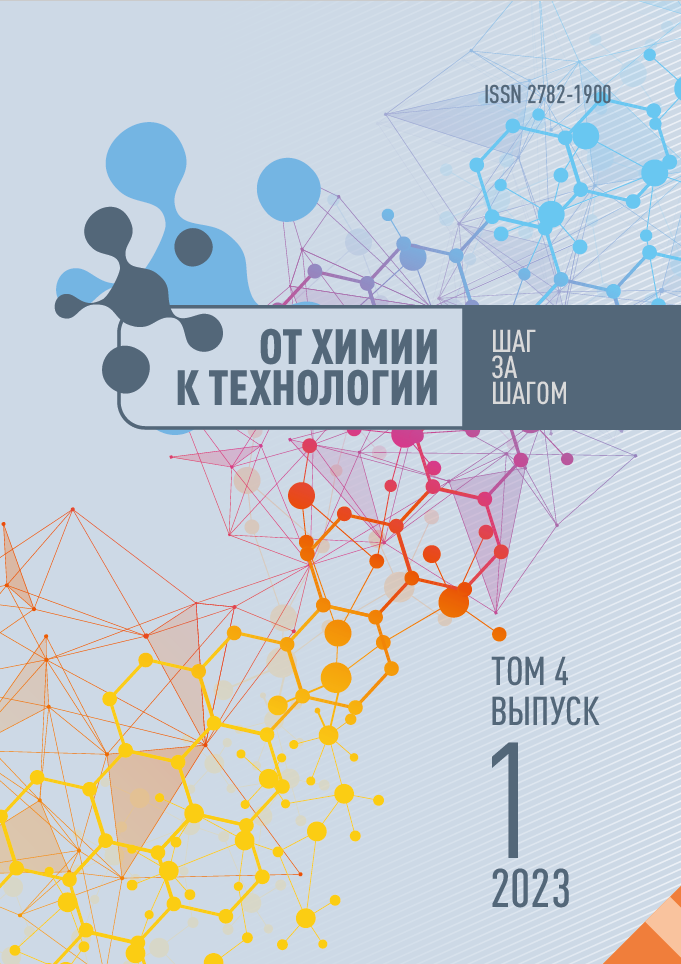Иваново, Ивановская область, Россия
Иваново, Ивановская область, Россия
студент
Иваново, Ивановская область, Россия
The paper presents the results of the cotton cellulose modification with glycine. To form dialdehyde-cellulose and its subsequent treatment with aminoacetic acid we conducted the modification through an oxidation stage of cellulose with sodium metoperiodate. We studied the sorption properties of the original and modified cellulose samples in relation to Cu(II) and Fe(II) ions. Bykinetic experiments we found the degree of extraction of copper(II) and iron(II) ions. The modified sample was approximately 25% higher compared to the original one. We obtained the most correct results when processing the kinetic sorption curves within the framework of pseudo-second order kinetics model. We determined the optimum conditions for modifying cotton cellulose to achieve maximum sorption of copper (II) and iron (II) ions and obtained the equilibrium-kinetic characteristics of modified and unmodi-fied cotton cellulose. When studying the sorption equilibrium in the heterophase system "cellulose sorbent - aqueous solution of metal sulfate" we took sorption iso-therms, processed them in the framework of Langmuir mode, and determined the values of the ultimate sorption capacity of the native and modified cellulose. We found the ultimate sorption capacity of the modified sorbent is about 1.5-2 times higher than the ultimate sorption capacity of native cotton cellulose. We have ob-tained IR spectra of native andmodified cellulose samples. Also we have performed elemental analysis and obtained images of the sorption materials surface structure based on cotton cellulose using SEM.
cotton cellulose, modification, aminoacetic acid, sorption, ions Cu(II) and Fe(II)
1. Beni, A.A. & Esmaeili, A. (2020) Biosorption, an efficient method for removing heavy metals from industrial effluents: A Review, Environmental Technology & Innovation, (17), 10050 [online]. Available at: https://doi.org/10.1016/j.eti.2019.100503
2. Humelnicu, D., Lazar, M.M., Ignat, M., Dinu, I.A., Dragan, E.S. & Dinu, M.V. (2020) Removal of heavy metal ions from multi-component aqueous solutions by eco-friendly and low-cost composite sorbents with anisotropic pores, J. Haz. Mat., (381), 120980 [online]. Available at: https://doi.org/10.1016/j.jhazmat.2019.120980
3. Yadav, S., Yadav, A., Bagotia, N., Sharma, A.K. & Kumar, S. (2021) Adsorptive potential of modified plant-based adsorbents for sequestration of dyes and heavy metals from wastewater, A review Journal of Water Process Engineering, (42), 102148 [online]. Available at: https://doi.org/10.1016/j.jwpe.2021.102148
4. Noli, F., Kapashi, E. & Kapnisti, M. (2019) Biosorption of uranium and cadmium using sorbents based on Aloe vera wastes, Journal of Environmental Chemical Engineering, (7), 102985 [online]. Available at: https://doi.org/10.1016/j.jece.2019.102985
5. Nikiforova, T.E., Kozlov, V.A. & Odintsova, O.I. (2015) Laws of distribution of copper (II) and nickel (II) ions at heterophase system aqueous solution - modified flax fiber, Ros. khim. zh. (Zh. Ros. Khim. ob-va im. D.I. Mendeleyeva, 59(4), pp. 76-84 (in Russian).
6. Quyen, V., Pham, T.- H., Kim, J., Thanh, D.M., Thang, P.Q., Le, Q.V., Jung, S.H. & Kim, T.Y. (2021) Bio-sorbent derived from coffee husk for efficient removal of toxic heavy metals from wastewater, Chemosphere, (284), 131312 [online]. Available at: https://doi.org/10.1016/j.chemosphere.2021.131312
7. Nikiforova, T.E. & Kozlov, V.A. (2012) Comparison of models of sorption of copper(II) and nickel(II) cations from aqueous solutions by cotton cellulose, Zhurnal fizicheskoy khimii, 86(10), pp. 1724-1729 (in Russian).
8. Anantha, R.K. & Kota, S. (2018) Bio-composites for the sorption of copper from aqueous solution: A comparative study, Groundwater for Sustainable Development, (7), pp. 265-276 [online]. Available at: https://doi.org/10.1016/j.gsd.2018.06.007
9. Agarwal, A., Upadhyay, U., Sreedhar, I., Singh, S.A. & Patel, C.M. (2020) A review on valorization of biomass in heavy metal removal from wastewater, J. Water Proc. Eng., (38), 101602 [online]. Available at: https://doi.org/10.1016/j.jwpe.2020.101602
10. Sancey, B., Trunfio, G., Charles, J., Minary, J.-F., Gavoille, S., Badot, P.-M. & Crini, G. (2011) Heavy metal removal from industrial effluents by sorption on cross-linked starch: Chemical study and impact on water toxicity, Journal of Environmental Management, (92), 765e772. DOI:https://doi.org/10.1016/j.jenvman.2010.10.033.
11. Aniagor, C.O., Abdel-Halim, E.S. & Hashem, A. (2021) Evaluation of the aqueous Fe (II) ion sorption capacity of functionalized microcrystalline cellulose, J. Env. Chem. Eng., (9), 105703 [online]. Available at: https://doi.org/10.1016/j.jece.2021.105703
12. Nikiforova, T.E., Kozlov, V.A., Loginova, V.A. (2014) Peculiarities of the adsorption of heavy-metal ions from aqueous media by modified cellulose, Adsorption Science & Technology, 32(5), pp. 389-402.
13. Mahajan, G. & Sud, D. (2013) Application of ligno-cellulosic waste material for heavy metal ions removal from aqueous solution, J. Env. Chem. Eng., (1), pp. 1020–1027 [online]. Available at: http://dx.doi.org/10.1016/j.jece.2013.08.013
14. Aniagor, C.O., Abdel-Halim, E.S. & Hashem, A. (2021) Evaluation of the aqueous Fe (II) ion sorption capacity of functionalized microcrystalline cellulose, Journal of Environmental Chemical Engineering, (9), 105703 [online]. Available at: https://doi.org/10.1016/j.jece.2021.105703
15. Nikiforova,T.E., Kozlov, V.A., Natareev, S.V. & Dubkova, E.A. (2014)The effect of plasma modification on the sorption properties of flax fiber, Izv. vuzov. Khimiya i khim. tekhnologiya, 7(3), pp. 91-97 (in Russian).
16. Mahour, S., Verma, S.K. & Srivastava, S. (2022) Functionalized agro-waste for toxic metal remediation from water bodies: A green pre-treatment process, Materials Today: Proceedings, (50), pp. 287–292 [online]. Availa-ble at: https://doi.org/10.1016/j.matpr.2021.06.330
17. Beaugeard, V., Muller, J., Graillot, A., Ding, X., Robin, J.-J. & Monge, S. (2020) Acidic polymeric sorbents for the removal of metallic pollution in water: A review, Reactive and Functional Polymers, (152), 104599 [online]. Available at: https://doi.org/10.1016/j.reactfunctpolym.2020.104599







